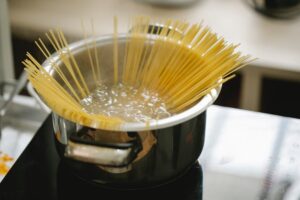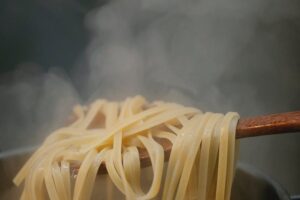We all love pasta, I mean, everyone is always ready to devour a mound of pasta. But in reality, what no one wants is an ACTUAL mound of pasta – one solidified mass you could pick up in one swoop with a fork.

Or small stuck-together piles merely resting on top of the sauce they should be slathered in. Would you like to learn how to avoid a gloopy mess and get the individually tender noodles you need?
Stay tuned as we explore some kitchen tips that’ll help you do just that. These tips will help you keep your pasta from sticking and skip straight to saucy satisfaction. As always, let’s dive in right away.
What causes this pasta issue, and why does it happen, seemingly at the most inconvenient times? Let’s unravel the sticky truth behind why pasta sticks together while cooking.
Why Pasta Stick When You’re Cooking It
- Starch, the Culprit: At the heart of the matter is the abundant starch found in pasta. Starch is a complex carbohydrate present in grains, and pasta is predominantly made from wheat flour, a starch-rich ingredient. During cooking, pasta releases starch into the water, which creates a sticky, glue-like substance.
- Insufficient Water: One of the leading causes of sticky pasta is using too little water for boiling. When there’s not enough water in the pot, the starch concentration becomes higher, making it more likely for the noodles to stick together. Think of it as a crowded party – too many guests (pasta) in a small room (insufficient water) leads to inevitable collisions.
- Neglecting the Stir: Another common culprit is neglecting to stir the pasta once it’s in the boiling water. Without stirring, the pasta strands can easily clump together, especially in the early stages of cooking. Stirring ensures that the noodles maintain their individuality.
- Overcooking Woes: Overcooking pasta is a prime reason for stickiness. When pasta is cooked past the point of al dente (which means “to the tooth” in Italian), it becomes softer and more prone to sticking. Overcooked pasta also releases more starch into the water, compounding the stickiness problem.
- High Temperature Boiling: Boiling pasta at an excessively high temperature can exacerbate the stickiness issue. The aggressive boiling action can break down the pasta’s outer layer, causing it to release more starch. A gentler simmer is preferable.
- Fresh Pasta Dilemma: Fresh pasta, while delicious, is notorious for sticking together. This is because fresh pasta has a higher moisture content compared to dried pasta. As it sits, fresh pasta releases moisture, which can lead to irreversible fusion. Dusting the sheets of fresh pasta with flour before and after cutting can help mitigate this problem.
Now that you know the culprits behind the sticky pasta situation, you have a better understanding of what happens. Many resort to adding oil to avoid this mess.
However, the goal of this article is to teach you how to cook pasta that won’t stick without adding oil. The next section explains just how to do that.
Unleash the Power of Perfectly Cooked Pasta

So, we’ve unraveled the mystery behind why pasta often sticks together during cooking. But fear not, for we’re not here to merely lay out the causes and leave you pondering your pasta predicaments.
We’re here to equip you with solutions – the secret ingredients to achieving that perfectly cooked pasta that won’t stick together, all without resorting to the slippery slope of using oil.
Ample Water is the Key
The first step in your pasta perfection journey is to ensure you have enough water in the pot. Forget about skimping on the water; pasta needs room to move.
And the starch it releases makes the situation stickier. If there’s not enough water for that starch to grow, it’ll have no other choice than to make clumpy noodles.
The specific ratio of quarts of water to pounds of pasta may vary depending on personal preference and the type of pasta.
Some cooks prefer using less water, especially for smaller portions, and simply stirring diligently during cooking to prevent sticking.
Stirring: The Pasta Polka
Don’t be a pasta wallflower! Once you’ve added your pasta to the boiling water, give it a twirl with your trusty cooking utensil. Ensure each strand dances freely in the water.
Stirring during the first few minutes of cooking is crucial. It prevents the noodles from clumping together and guarantees a harmonious pasta party.
Add Pasta to Boiling Water
No, I don’t mean simmering. Keep going – it should be bubbling rapidly and steaming heartily. No matter how impatient your stomach might be, when making your dinner, don’t add your pasta beforehand.
It’s a one-way ticket to a gummy ball of gluten.
Al Dente: The Sweet Spot
Master the art of cooking your pasta to “al dente.” This Italian term, meaning “to the tooth,” signifies the perfect balance between tenderness and firmness.
To achieve this, follow the recommended cooking time on the pasta packaging but taste-test a minute or two before it’s due.
Al dente pasta has a slight resistance when bitten into, which not only enhances the texture but also reduces the chances of sticking.
Reserve Pasta Water
This might seem counterintuitive, but it’s a top chef’s secret. Before draining your pasta, reserve a cup of the starchy cooking water.
This liquid gold can be a game-changer when it comes to creating a silky sauce that clings perfectly to your noodles. Simply add it to your sauce as needed to achieve that ideal consistency.
Rinsing: To Rinse or Not to Rinse
Rinsing pasta after cooking is a practice often discouraged. While it can be helpful when preparing pasta for a cold salad, it’s not the best option for hot pasta dishes.
Rinsing hot pasta washes away the valuable starch on the surface that helps sauces adhere. Rinsing pasta should be avoided for hot pasta dishes, and if you do rinse it, you generally don’t need to add oil if you’re using it in a hot dish.
Timing is Crucial

Aim to finish your sauce and noodles at the same time. Keeping the pasta in the colander while the sauce finishes is a common method used by many cooks, and it doesn’t necessarily lead to their fusing.
It’s a matter of personal preference and convenience. Rinsing them in cold water in the colander is no good either. This is because all the lovely starch that helps the sauce adhere will be flushed down the drain.
Embrace Quality Pasta
Invest in good-quality pasta. Quality pasta is often made using durum wheat semolina, which holds its shape well during cooking.
While high-quality pasta can enhance your dish, it’s important to note that lower-quality pasta can still be cooked to perfection. You can do this if you follow the right cooking techniques or the previously outlined steps.
Wrap Up
By implementing these solutions and mastering the art of pasta preparation, you’ll be well on your way to a pasta-cooking pro.
Say goodbye to sticky pasta and welcome perfectly cooked separate strands that eagerly await the sauce of your choice. Cooking pasta should be an enjoyable, rewarding experience.
With these solutions in your culinary toolbox, you’re all set to create pasta dishes that impress. So, get your water boiling, your pasta dancing, and your taste buds ready for a culinary masterpiece.
